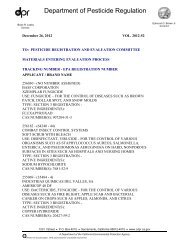Dichlorvos (DDVP) Risk Characterization Document - California ...
Dichlorvos (DDVP) Risk Characterization Document - California ...
Dichlorvos (DDVP) Risk Characterization Document - California ...
You also want an ePaper? Increase the reach of your titles
YUMPU automatically turns print PDFs into web optimized ePapers that Google loves.
transmitter of signals from the nerve to another nerve or muscles. The inhibition of ChE results in<br />
cholinergic signs such as salivation, diarrhea, tremors, respiratory failure, and death due to the<br />
accumulation of acetylcholine and over-stimulation of nerves or muscles. USEPA has proposed the<br />
revocation of <strong>DDVP</strong> tolerances for processed commodities because of concerns on <strong>DDVP</strong>-induced<br />
cancer in experimental animals.<br />
TOXICOLOGY<br />
Cholinergic signs (tremors and diarrhea) and death in experimental animals were the most sensitive<br />
endpoints for the acute toxicity of <strong>DDVP</strong> after inhalation and oral exposures. The dose (the noobserved-effect<br />
level or NOEL) at which death and cholinergic signs did not occur was used to<br />
quantitate the hazard for potential one-time exposure to humans. The long-term (chronic) health<br />
hazard to humans from repeated exposures to <strong>DDVP</strong> was evaluated based on the inhibition of<br />
cholinesterase activity in the brain observed in both inhalation and oral studies. The cancer risk from<br />
lifetime exposure was evaluated based on the finding of leukemia in rats after chronic oral exposure.<br />
EXPOSURE ANALYSIS<br />
The potential exposure scenarios of humans to <strong>DDVP</strong> include the work place, home, and the food.<br />
Workers are exposed to <strong>DDVP</strong> in the work place due to warehouse fumigation, livestock applications,<br />
and structural applications. The general population is exposed to <strong>DDVP</strong> in the home from the uses as<br />
directed spray, fogger, flea collars, and no-pest strips; as well as in the diet from the use of <strong>DDVP</strong> on<br />
vegetables, livestock, and processed foods. The worker exposure was also assessed in combination<br />
with exposure at home (from home use and in the diet).<br />
RISK EVALUATION<br />
A margin of safety (MOS) of at least 100 is generally considered sufficient to be protective of human<br />
health. The following exposure groups have MOSs greater than 100: chronic exposure of residents<br />
after structural fumigation; acute and chronic exposures of pet owners to flea collars; acute dietary<br />
exposure of all population subgroups; and chronic dietary exposure of all subgroups, except children 1<br />
to 6 years old.<br />
The following exposure groups have MOSs less than 100 for non-oncogenic effects: acute, chronic,<br />
and lifetime exposures for all workers exposed to <strong>DDVP</strong> only at work and in combination with<br />
exposure at home; acute exposure of residents after structural fumigation; acute, chronic, and lifetime<br />
exposures of residents to home-use foggers; acute and chronic exposures of children to no-pest<br />
strips; and chronic dietary exposure of children 1 to 6 years old.<br />
For oncogenic effects, the excess lifetime oncogenic risks of the workers, residents, and the general<br />
population exposed to <strong>DDVP</strong> at work, at home, or in the diet and in combinations were greater than<br />
the benchmark oncogenic risk level of 1 x 10 -6 which is generally considered protective of human<br />
health.<br />
The MOSs for the acute exposure to <strong>DDVP</strong> on vegetables and livestock products at tolerance levels<br />
are greater than 100.<br />
ii
















